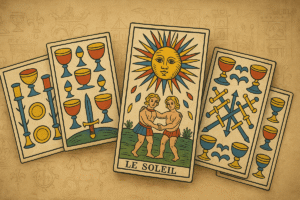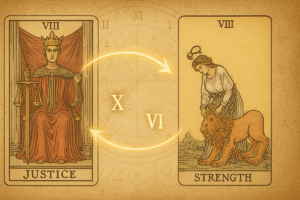Table of Contents
When you pick up a modern tarot deck, something remarkable happens without you even noticing it. You look at the Five of Cups and immediately see a figure in a black cloak, grieving over spilled cups while two remain standing behind them. The story is right there, painted into the card itself. But this wasn’t always how tarot worked.
For centuries, the Minor Arcana cards showed exactly what their names suggested. The Eight of Swords? Eight swords arranged in a pattern. The Three of Pentacles? Three coins, maybe in a decorative layout. These pip cards, as they’re called, left all the interpretation work to the reader’s memory and imagination. You had to know what each number meant, understand the suit’s element, and somehow weave those abstract concepts together into something meaningful.
Then Pamela Colman Smith came along and changed everything.
The World Before Illustrated Cards
I think it’s easy to forget how radical this shift actually was. Perhaps because we’re so used to richly illustrated decks now, we don’t realize that for most of tarot’s history, the Minor Arcana were basically playing cards with mystical associations.
The Tarot de Marseille, which dominated European divination for generations, exemplified this older approach perfectly. Open up the suit of Wands and you’d see staffs or batons arranged in geometric patterns. The Seven of Wands showed seven staves. The Nine of Wands showed nine. Beautiful, certainly, with their ornate borders and careful symmetry. But they didn’t tell you a story. They didn’t whisper suggestions about what that nine or that seven might mean in the context of someone’s question about their job or their relationship or their creative project.
Readers who worked with these decks needed extensive training. They memorized correspondences between numbers, suits, and meanings. They studied systems that linked each card to astrological signs, kabbalistic concepts, or elemental associations. The cards were tools for people who already knew the language. For everyone else? They were pretty much impenetrable.
Some decks did include scenic Minor Arcana before Smith’s work, though they’re often overlooked in popular histories. The Sola Busca tarot from the 1490s featured detailed illustrations across all its cards, including the Minor Arcana. But this deck remained obscure, a curiosity rather than a widely used tool. It didn’t change how most people practiced tarot reading.
Pamela Colman Smith’s Vision
In 1909, Pamela Colman Smith sat down to create what would become the Rider Waite Smith deck, working under the direction of Arthur Edward Waite. The project itself wasn’t particularly unusual. New tarot designs appeared regularly in occult circles. What Smith did with the Minor Arcana, though, was genuinely revolutionary.
She drew pictures for all of them. Not decorative arrangements of suit symbols, but actual scenes with people, animals, landscapes, and narrative moments frozen in time. Every single card from Ace to Ten in all four suits received its own miniature illustration.
The decision might seem obvious now, but it represented a fundamental reimagining of what these cards could do. Smith wasn’t just decorating. She was encoding interpretation directly into the imagery. When you look at her Three of Swords, you see three blades piercing a heart against a stormy sky. The meaning practically announces itself. Heartbreak. Painful truth. Emotional piercing. You don’t need to remember that three represents growth and swords relate to the mind. The picture does much of that work for you.
Smith worked incredibly quickly, completing all 78 cards in just a few months. She drew from her background in theater and her exposure to the symbolism that Waite provided, but she also brought her own artistic sensibility. Her figures have a storybook quality, a slight flatness that somehow makes them more archetypal rather than less. They feel like they exist in a realm slightly removed from ordinary reality.
How Illustration Changed Everything
The illustrated minor arcana transformed tarot from an expert’s tool into something approachable for beginners. This wasn’t about dumbing anything down. It was about creating multiple entry points into the cards’ meanings.
An experienced reader might still draw on traditional correspondences, elemental associations, and numerological patterns. But now a complete novice could pick up the deck and receive intuitive hits just from looking at the images. The cards began to function as visual prompts for reflection rather than coded symbols requiring translation.
This shift had profound practical effects. Reading tarot became less about memorizing meanings and more about developing a relationship with the imagery. What do you see in the Six of Pentacles when you look at the figure distributing coins to the beggars? Maybe you notice the scales he holds, suggesting balance and fairness. Maybe you focus on the power dynamic, the way the giver stands elevated above those receiving. Perhaps your eye catches the detail of how carefully the coins are being weighed before distribution.
Different readers could find different emphases within the same card, and the illustrations supported that interpretive flexibility. The pictures were specific enough to suggest meanings but open enough to accommodate various perspectives. This balance between clarity and ambiguity proved remarkably powerful.
The Accessibility Revolution
Making tarot more accessible wasn’t just about making it easier. It democratized a practice that had been somewhat gatekept by those with formal training or extensive occult study. Suddenly, you didn’t need to join an esoteric order or study for years before the cards would speak to you.
This matters more than I initially realized when I first started exploring tarot’s history. The illustrated minor arcana essentially invited in a whole new population of readers who might have found the pip style too intimidating or abstract. People who thought visually, who trusted their intuitive responses to images, who wanted to engage with symbolic material without necessarily committing to extensive study.
The cards could now function as prompts for personal reflection. Someone pulling the Four of Cups might not know its traditional association with contemplation and apathy, but they could see the figure sitting under a tree, arms crossed, ignoring the cup being offered by the mysterious hand. That image alone invites questions. What am I ignoring? What opportunities am I too distracted or disengaged to notice? The illustration guides the reflection without dictating a single correct interpretation.
Artistic Influence and Legacy
Nearly every popular tarot deck created in the past century owes something to Smith’s innovation. Even decks that deliberately return to pip style cards do so as a conscious artistic choice, aware that they’re working against the dominant paradigm that Smith established.
The illustrated approach enabled endless creative variations. Modern deck creators can reimagine the scenes Smith depicted, shifting cultural contexts, adding contemporary elements, or emphasizing different aspects of each card’s traditional meaning. The Wild Unknown Tarot strips imagery down to essential elements but still provides visual scenes. The Modern Witch Tarot updates Smith’s scenarios with diverse characters and current settings. The Tarot of the Divine weaves in global folklore and fairy tales.
All these variations rest on the foundation Smith built when she chose to illustrate those 56 cards. She created a template flexible enough to accommodate countless artistic visions while maintaining the core function she pioneered. The cards tell stories. The stories prompt reflection.
What We Gained and Perhaps Lost
The move from pips to pictures wasn’t without trade offs, though. Some readers and scholars argue that the illustrated approach can actually limit interpretation by suggesting too specific a narrative. When the Five of Pentacles shows two destitute figures walking past a church window in the snow, that powerful image of poverty and exclusion might overshadow other potential meanings related to the number five or the earth element.
Pip cards, by their abstraction, force the reader to synthesize meaning from multiple symbolic systems. There’s an argument that this creates deeper engagement with tarot’s underlying structures. The starkness of seeing just five coins arranged in a pattern requires you to think about what five means, what pentacles represent, and how those concepts might combine in the context of a reading.
I’m not entirely convinced that illustration truly restricts meaning as much as critics suggest, but the concern isn’t baseless. Images do guide perception in particular directions. Smith’s artistic choices, made more than a century ago, continue to shape how millions of readers understand these cards today. That’s both the genius and the limitation of her innovation.
The Modern Reading Experience
Today, when someone begins exploring tarot, they almost certainly start with an illustrated deck. The Rider Waite Smith itself remains the bestselling tarot deck worldwide, and its imagery has become the default visual language of tarot. Even people who’ve never held a tarot deck often recognize Smith’s artwork when they see it.
This ubiquity means that illustrated minor arcana have become simply how tarot works for most contemporary practitioners. The innovation has become invisible through its complete success. We don’t think about how remarkable it is that a card depicting eight swords binding a figure can communicate so immediately. We just accept that the cards speak through their images.
The illustrated approach also shaped how tarot moved into mainstream culture. When tarot appears in films, television shows, or other media, it’s almost always depicted with scenic Minor Arcana. This reinforces the public perception of tarot as a visual, intuitive practice rather than a complex system requiring esoteric knowledge. Whether that’s entirely accurate doesn’t change the cultural impact.
Reflection as Innovation
What strikes me most about Smith’s illustrated minor arcana isn’t just that she made tarot more accessible. She fundamentally changed what the cards were for. By making the meanings visible, she shifted tarot toward introspection and away from pure divination. The images don’t predict. They reflect. They ask questions rather than answer them.
This aligns remarkably well with how many people use tarot today, as a tool for self exploration rather than fortune telling. The illustrations serve as prompts for examining your own thoughts, feelings, and situations. What aspects of the image resonate with you? What do you notice? What does the scene remind you of in your own life?
Perhaps that’s the real revolution. Smith gave us pictures that function as mirrors.







